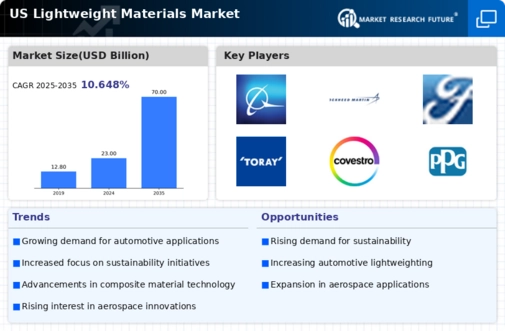The US Lightweight Materials Market is characterized by significant advancements and competitive dynamics driven by the increasing demand for fuel-efficient and high-performance materials across various industries such as aerospace, automotive, and construction. The market consists of several key players who are focused on innovation, product development, and strategic partnerships to enhance their offerings and maintain competitive advantages. This sector is evolving rapidly as companies seek to leverage lightweight materials to improve performance while reducing weight and enhancing overall efficiency.
The competitive landscape is marked by continuous investment in research and development, leading to the introduction of advanced materials such as aluminum alloys, composites, and polymers that offer superior strength-to-weight ratios. These dynamics create an environment where players must remain agile and responsive to shifts in technology and consumer preferences, all while navigating regulatory hurdles and sustainability concerns.Boeing stands out in the US Lightweight Materials Market by being a pioneer in aerospace lightweight solutions, actively investing in innovative materials technology to meet the industry's evolving demands.
The company’s commitment to sustainability and efficiency is evident through its extensive use of composite materials in aircraft production, which contributes significantly to weight reduction and fuel efficiency. Boeing's strong brand presence and established relationships with suppliers and customers allow it to leverage economies of scale, thereby achieving cost advantages in the production processes. Additionally, Boeing's dedication to advancing lightweight technology through strategic collaborations and investments in research organizations enhances its competitive position in the market.
The company’s focus on developing next-generation aircraft continues to drive its efforts in using lightweight materials effectively, reinforcing its leadership status within the aerospace sector.Lockheed Martin is another significant player in the US Lightweight Materials Market, renowned for its innovative approaches and commitment to utilizing advanced materials in defense and aerospace applications. The company is focused on integrating high-strength composites and lightweight metals into various platforms, most notably in military aircraft and advanced technologies.
Lockheed Martin's strengths lie in its robust research and development capabilities, allowing it to create cutting-edge lightweight solutions tailored to meet the unique requirements of defense operations and aerospace missions. The company continuously invests in mergers and acquisitions aimed at enhancing its material technology and expanding its market reach within the lightweight materials sector. Lockheed Martin's strategic partnerships with material suppliers and research institutes further position it to remain at the forefront of material innovation, contributing to the modernization of defense capabilities while maintaining a competitive edge in the US market.

























Leave a Comment